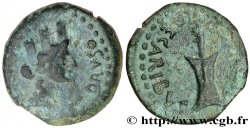brm_1046314 - TIBERIUS Denier
200.00 €(Approx. 234.00$ | 174.00£)
Quantity
Add to your cart

Type : Denier
Date: c. 15-22
Mint name / Town : Lyon
Metal : silver
Millesimal fineness : 950 ‰
Diameter : 18 mm
Orientation dies : 11 h.
Weight : 3,45 g.
Coments on the condition:
Monnaie centrée, fourrée. Joli revers. Patine grise, tachée
Catalogue references :
Obverse
Obverse legend : TI CAESAR DIVI - AVG F AVGVSTVS.
Obverse description : Tête laurée de Tibère à droite (O*).
Obverse translation : “Tiberius Cæsar Divi Augusti Filius Augustus”, (Tibère César fils du divin Auguste, auguste).
Reverse
Reverse legend : PONTIF - MAXIM.
Reverse description : Pax (la Paix) ou Livie assise à droite sur un siège décoré, tenant une branche d'olivier de la main gauche et de la droite un long sceptre.
Reverse translation : “Pontifex Maximus”, (Grand pontife).
Commentary
Monnaie fourrée. Faux d’époque. Comme pour le denier d'Auguste, cette pièce appartient à l'atelier impérial de Lyon et ce type de denier a circulé pendant pratiquement un siècle. Il se rencontre très souvent avec des monnaies gauloises de la phase terminale dans les fouilles archéologiques. C’est la monnaie romaine la plus courante en Gaule pour les Julio-Claudiens. La première émission se caractérise par un socle représenté par deux lignes et les pieds du siège sont droits au revers.
Filled coin. Period fake. As with the denarius of Augustus, this coin belongs to the imperial workshop of Lyon and this type of denarius circulated for almost a century. It is very often found with Gallic coins from the final phase in archaeological excavations. It is the most common Roman coin in Gaul for the Julio-Claudians. The first issue is characterized by a base represented by two lines and the feet of the seat are straight on the reverse
Filled coin. Period fake. As with the denarius of Augustus, this coin belongs to the imperial workshop of Lyon and this type of denarius circulated for almost a century. It is very often found with Gallic coins from the final phase in archaeological excavations. It is the most common Roman coin in Gaul for the Julio-Claudians. The first issue is characterized by a base represented by two lines and the feet of the seat are straight on the reverse








 Report a mistake
Report a mistake Print the page
Print the page Share my selection
Share my selection Ask a question
Ask a question Consign / sell
Consign / sell
 Full data
Full data











